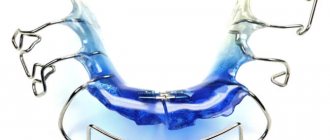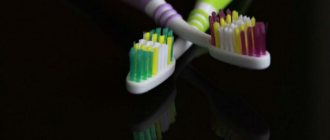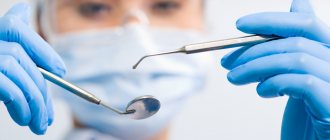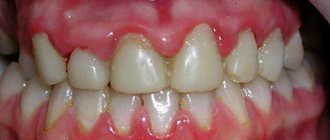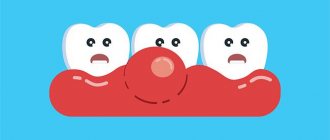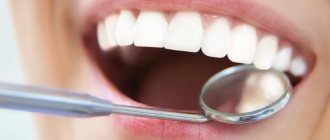Author of the article:
Soldatova Lyudmila Nikolaevna
Candidate of Medical Sciences, Professor of the Department of Clinical Dentistry of the St. Petersburg Medical and Social Institute, Chief Physician of the Alfa-Dent Dental Clinic, St. Petersburg
Weak and loose gums are a problem that many people face today. As a rule, the appearance of this defect is preceded by inflammatory periodontal diseases, such as gingivitis and periodontitis. Patients with such diseases suffer from a number of unpleasant symptoms:
- Severe redness, swelling of the gums;
- Bleeding while eating or brushing teeth;
- Tooth mobility;
- The formation of “pockets” - spaces between the tooth and gum, in which food debris, bacterial mass, and, in some cases, pus accumulate;
- Exposure of the cervical area of the teeth, and in severe cases, the roots.
- Strong, pungent odor from the mouth.
The listed symptoms are only the most harmless consequence of weakening gum tissue. In the absence of proper treatment, it threatens the loss of teeth, including healthy ones. That is why strengthening the gums and teeth is the primary task of the dentist and periodontist when treating patients with such problems. However, today it is also possible to strengthen gums at home. You will learn how to strengthen your gums and teeth yourself from our material.
Causes associated with dental diseases
The cause of loose teeth in the gums can be various dental diseases, such as periodontitis, periodontal disease, periodontitis and gingivitis. Incorrect bite can also trigger the appearance of this disease.
With gingivitis, many bacteria live in the oral cavity, which cause bleeding gums and, as a result, loosening of teeth.
With periodontitis, the same symptoms are present, but they are also accompanied by bad breath and inflammatory processes in the gums begin. The cause of both diseases is poor oral hygiene.
Periodontal disease is not associated with inflammatory processes and is accompanied by a decrease in the bone walls between all teeth, resulting in bleeding and itching in the gums, and the teeth become mobile and their sensitivity increases.
Special devices
Irrigator. This is a device that supplies a thin stream of water under an adjustable pressure (can be pulsating). It is used to clean the entire surface of tooth enamel, including areas that are difficult to access. Regular use of an irrigator reduces the formation of tartar and plaque, reduces the risk of caries and inflammatory processes, and ensures high-quality oral hygiene.
The irrigator is used in different modes. If you are predisposed to periodontitis, periodontal disease, or other diseases, it is advisable to choose a model that can perform hydromassage. It is carried out quickly and does not cause discomfort. Hydromassage of the gums with an irrigator improves their condition, accelerates blood circulation, and strengthens them. The frequency of use of the irrigator and its operating modes are selected by the treating dentist or periodontist.
Massagers. Can be mechanical or electrical. They stimulate blood flow to periodontal tissues, increase the supply of oxygen to their tissues, and strengthen them. Effective in the prevention of periodontal disease. Massage prevents the appearance of inflammatory processes and can relieve them if there is sensitivity or pain.
Causes of disease not related to gum disease
Dental disease is not the only factor that causes loose teeth. This process can occur for a number of other reasons:
- As a result of genetic predisposition to the disease.
- Weakening of the immune system.
- Diabetes.
- Hormonal imbalances.
- Psoriasis.
- Trauma to the maxillofacial area.
- Arthritis.
Only a dentist can correctly determine the cause of the disease. If the teeth are loosened as a result of a strong blow, the doctor sends the patient for an x-ray for a more detailed diagnosis, and then decides on subsequent treatment. If the cause is a chronic disease, the doctor will prescribe dental procedures or prescribe the appropriate medication to strengthen the gums.
Is this the end for them? Is it possible to restore gums with periodontal disease?
Sometimes, in adulthood, people begin to notice the exposure of the necks of their teeth, their lengthening, as well as receding gums at the base of the tooth. The process of gum atrophy and destruction is called periodontal disease.
It is not so common, but the course is always chronic, and a clear clinical picture, in which a person understands that it is time to see a specialist, appears after ten, and sometimes more, years. Unfortunately, at this stage, prevention is already useless; the gums are destroyed, which leads to tooth loss .
It is believed that hereditary predisposition plays an important role in the occurrence of periodontal disease. Diabetes mellitus, hypertension, atherosclerosis and other disorders of the internal organs and metabolic processes in the body can also provoke the disease
Diet and vitamins
Proper, balanced nutrition is necessary for gum health. To strengthen the mucous membranes and blood vessels, you need to eat foods high in vitamin C, such as citrus fruits and green leafy vegetables. Vitamin K, found in large quantities in green vegetables and herbs, has a similar effect. Antioxidants and tannins contained in green tea and red wine have an anti-inflammatory and healing effect, slowing down the aging process. In addition, it is important to consume enough phosphorus, calcium and zinc - they are contained in seafood, garlic and onions, and dairy products.
Vitamin complexes are well suited as an additional source of nutrients - in particular, the vitamin-mineral complex for teeth ASEPTA. It contains vitamins A, B3 and B6, C, D3, as well as coral calcium and green tea extract. In addition, coenzyme Q10, which is contained in the complex, has a powerful regenerating effect and restores damaged gum tissue.
Preparations for the treatment of periodontal disease
Medications are rarely used in the treatment of periodontal disease, since bacterial inflammation rarely accompanies the disease. If necessary, the following drugs are prescribed:
- Carotinoly-M is an antioxidant of animal origin. Rejuvenates gums, saturates them with vitamins A, D, E, F.
- Heparin ointment thins the blood, stimulates microcirculation of periodontal tissues, and saturates them with oxygen.
- Troxevasin in gel form improves blood circulation, strengthens the vessels of the periodontal tissues, and has a strong anti-periodontal effect.
- Aloe extract. The course includes 20-25 injections into the gums every other day. The drug enhances cellular metabolism.
The duration of treatment is determined by the periodontist. As a rule, therapy lasts from 10 days to several months.
Folk remedies for treating illness
Regular rinsing of the mouth with special solutions or decoctions of medicinal plants is an excellent remedy for strengthening the gums. For this purpose, you can use decoctions of oak bark, eggplant peel, and horseradish. The most popular herbs for strengthening gums are chamomile, sage, St. John's wort, mint, and burdock.
Four folk recipes for rinsing to strengthen gums:
- Tea tree oil is an effective remedy for strengthening weak gums due to its ability to heal wounds and fight bacteria. To prepare a solution that needs to be used to rinse the mouth, take 2 drops of oil and half a glass of clean water.
- One of the popular folk recipes is a tincture made from a mixture of linden blossom and oak bark in equal proportions. To prepare it, just take a teaspoon of each component and pour 2 cups of boiling water over them. You should rinse your mouth with the resulting product after each meal.
- You can disinfect the oral cavity with cognac. To do this, you need to rinse it with a small amount of drink.
- Burdock decoction. The product should be used at least twice a day. To prepare it, you need to boil a tablespoon of the herb in 500 milliliters of water, then cool and strain through cheesecloth or a sieve.
To strengthen the gums and teeth, it is recommended to massage with the thumb and forefinger. The gums are treated with vertical massaging movements - from one tooth to another. Each section should be worked for 20 seconds. To increase efficiency, you can carry out the procedure by first dipping your fingers in honey or tea tree oil.
To strengthen the gums, it is recommended to use lotions:
- Plantain juice helps a lot. A cotton or gauze swab is moistened in it and applied to the gum.
- A decoction of young pine needles. To prepare the lotion, you need to boil 3 tablespoons of needles in 200 milliliters of water for 10 minutes. After this, the product is infused for at least 7 hours. A cotton swab dipped in the broth is applied to the sore gums.
Recovery methods
There are the following options for gum extension:
- Vestibuloplasty . A surgical method for correcting the oral cavity, consisting of redistribution of mucous membranes. It is aimed at deepening the space between the lip and teeth. Helps get rid of multiple gum recessions and exposure of dental roots. It is carried out for speech therapy, cosmetic and orthodontic indications.
- Gingivoplasty . It is used for uneven gingival contours, recession, and pathological periodontal pockets. Helps improve the aesthetics of the lower part of the face and remove an unsightly shark smile. The dentist-surgeon carefully excises excess tissue and transplants it into “deficient” areas. The intervention is considered quite simple.
The specialist decides what type of correction to apply, taking into account the existing diagnosis and the severity of the disorder, the characteristics of the client’s health condition
Ointments and gels
The main advantage of gels and ointments compared to rinses is their ability to remain longer on the surface of the gum mucosa - and, as a result, provide a therapeutic effect for a longer time. ASEPTA healing gel contains propolis, a component of natural origin that has antibacterial, anti-inflammatory and regenerating effects. Thanks to this, the gel, when used regularly, can eliminate almost all the unpleasant symptoms that accompany weakening gums, as well as have a positive effect on the condition of the tissues themselves. The product is applied twice a day to the affected areas (necessarily after thorough brushing of the teeth). After using it, do not consume food or liquid for half an hour. This gel allows you to quickly strengthen your gums at home.
An equally effective remedy is the adhesive balm ASEPTA. The sticky pectin base prevents saliva from washing off the balm from the surface of the mucous membrane - its antimicrobial effect lasts more than half an hour. The balm contains powerful antiseptic components - chlorhexidine and metronidazole, which can prevent the development of inflammatory gum diseases - gingivitis and periodontitis.
What causes gum pain?
The two main types of gum disease are gingivitis and periodontal disease. Gingivitis
is the initial stage of gum disease and may go unnoticed.
At the same time, gingivitis and its consequences are quite easy to treat. Periodontal disease, or periodontitis
, is an inflammation of the gums that results from untreated gingivitis. Periodontal disease leads to tooth decay and severe infection of the gums in the affected area of the mouth. Ultimately, this process ends in tooth loss and bone diseases in the mouth.
Toothpaste for strengthening gums
Therapeutic and prophylactic toothpastes are also an excellent tool for combating looseness of gingival tissue. Proper brushing of teeth is effective in itself - by massaging the gums with a brush, we improve blood circulation in the tissues and remove plaque, which is a constant source of infectious danger. In addition, many pastes contain antiseptic components that kill pathogens. However, it should be remembered that such pastes cannot be used for a long time, as this may negatively affect the state of the natural microflora of the teeth.
For regular use, pastes based on natural ingredients are better suited. For example, ASEPTA and ASEPTA Sensitive toothpastes contain extracts of calendula, sage, St. John's wort, sweet clover, calamus and other medicinal plants that relieve inflammation, eliminate bleeding and have a mild antiseptic effect. ASEPTA Sensitive paste also contains minerals - potassium citrate and hydroxyapatite, which increase the resistance of teeth to caries.
You can’t let the disease run!
Do not neglect regular dental examinations, then the problem will be detected at an early stage, which will help solve it faster.
Other publications:
Reviews about bone grafting in dentistry: How much bone tissue is needed for an implant: Preparations for dental bone resorption: What tissues include cartilage and bone tissue: What cells destroy bone tissue:
Only with us: Enter promotional code bonus2021 in the coupon field when placing an order until March 31, 2021 and receive a 25% discount on everything!
How to strengthen teeth and gums? Basic recommendations
List of recommendations for strengthening gums:
- Use special toothpastes.
- Introduce dairy products into your diet, as well as foods containing large amounts of vitamin D.
- Use rinse aids.
- Use floss to clean teeth in hard-to-reach areas.
- See your dentist regularly to check the condition of your teeth and gums.
See your dentist regularly to check the condition of your teeth and gums.
An integrated approach to treatment
To stop the further development of the disease and eliminate discomfort, you must do the following:
- diagnose the disease to prescribe appropriate therapy
- remove deposits and stones from teeth
- treatment of inflammation
- sanitize the oral cavity
If necessary, loose teeth are splinted, dentures are placed, and teeth that cannot be treated are removed. After completing the treatment course, maintenance therapeutic procedures are prescribed. Only an integrated approach guarantees complete cure of inflammation, and following the recommendations will avoid relapses.
Consultation and initial examination of a specialist
At the first visit to the dentist, the patient undergoes an initial examination and receives advice on possible treatment methods for the identified disease. After a thorough examination of each tooth, the doctor records data on the condition of the teeth and gums in the patient’s medical record. The visitor is given information about which and how teeth need to be treated, and the approximate cost of the necessary procedures can be calculated.
Anti-inflammatory therapy
The problem of gum inflammation is a common phenomenon, however, self-medication cannot get rid of it. In order not to start the disease and not lose teeth, you should promptly seek the help of a dentist.
The combined use of conservative local therapy and physiotherapy gives good results. Medications used in the treatment of periodontitis are divided into several categories:
- antibacterial agents (antifungals, antiseptics, antibiotics)
- enzymatic, steroidal and non-steroidal drugs
- hormonal, immunostimulating agents, vitamins
If the inflammation worsens, an operation may be prescribed to open the gums so that the accumulated pus can be released. For periodontitis, planned operations are performed:
- patchwork
- gingivectomy
- curettage
Physiotherapeutic procedures are prescribed after getting rid of severe inflammation.
Treatment of inflammation caused by injury
There are two types of gum injuries - chronic and acute. The former are a consequence of the action of a constant irritating factor - an incorrectly installed prosthesis, unsuccessfully made bridges, crowns, etc. In this case, you cannot do without contacting an orthopedic doctor. Acute injuries can occur when using cutlery, dental floss or a hard brush, as well as in fights and falls.
Anti-inflammatory treatment is carried out by a periodontist. First, it is necessary to eliminate the cause of the inflammatory process:
- replacement of old or low-quality fillings is carried out
- uncomfortable dentures are removed
- It is recommended to buy a soft toothbrush
Next, the treatment course is carried out in stages:
- acute pain is relieved
- anti-inflammatory therapy is prescribed
Features of choosing toothpaste and brush
A toothbrush is a personal hygiene item; it should be individual for everyone. The brush should not be used for more than two to three months.
If there are no problems with your gums, a medium hardness toothbrush will do. If there are any gum diseases, then the brush should be soft to avoid injury to the gums.
If you are used to using an electric brush, then you need to know that you should not brush your teeth for more than 3 minutes, and the brush movements are the same as when brushing with a regular brush. To reduce the load on the teeth, the electric brush should be applied to the surface of the teeth with less force compared to a regular one.
The choice of paste and the rules for using it are of great importance. Don’t think that the more toothpaste you squeeze out of the tube, the better you can clean your teeth. The volume of the paste does not affect the quality of the procedure - just squeeze out a little paste, the size of a pea.
The selection of toothpaste is also individual and depends on the condition of the gums and teeth. If your gums are bleeding, then the toothpaste should contain antibacterial and anti-inflammatory components. Most often these are medicinal plants: chamomile, eucalyptus, oak bark, sage, coniferous extracts, echinacea and others. Paste with propolis works well.
As a prophylactic paste, you should use those containing zinc citrate and aluminum lactate. They have an astringent effect and prevent periodontal disease and periodontitis. To restore mucous membranes, you need to buy pastes containing allantoin and bisabolol.
To choose the most suitable paste for your case, it is better to seek the help of a dentist. After examining and assessing the condition of the oral cavity, the doctor will be able to recommend exactly the paste that you need to prevent disease or as part of a treatment course for existing inflammation.
Consumer Reviews
Kotty about Asepta adhesive gum balm (otzovik.com)
“I had to purchase this adhesive balm because the dentist diagnosed me with periodontal disease. Therefore, when I have gum inflammation, I use this drug in courses every 6 months. I must note that the drug very quickly exerts its healing effect on the gums. The pain goes away immediately after starting treatment.
The dentist recommended that I lubricate my gums at night, once a day for 7 days.
Having studied the composition, I saw there such a substance as metronidazole and chlorhexidine. I realized that metronidazole is still an antibiotic. But since I was prescribed this medicine, I was calm. Although, frequent use of substances such as chlorhexidine and metronidazole on the skin and mucous membranes is undesirable, because the protective properties that the mucous membrane and skin should produce may cease to be produced. The dentist told me this too. Therefore, it is very important to use such products only for their intended purpose and strictly according to the instructions.
Of the indicated effects of the balm on the gums, the following were indicated:
- pronounced antibacterial effect on the gums;
- relieving inflammation and bleeding gums;
- breath freshening.
The package also contained a special plastic spatula, which was used to apply the balm to the gums. I must say that it is very comfortable. The balm itself is very thick and hardens after application. But the taste is generally tolerable.
I am satisfied with the effect of the balm. Good quality. It's not that expensive, considering that it lasts a long time. I recommend".
Minuto4ka about Asepta mouthwash (otzovik.com)
“Mint is an acquired taste, in everything. For example, I can completely tolerate it and love it. But I know a lot of people who can’t stand tongue-biting additives.
These are the first associations that arose for me when I first used this mouthwash.
It is sweet and has a lime flavor. And absolutely non-biting.
They prescribed it to me for absolutely no reason, of course.
My dentist prescribed it for me. For gums, which really bother me due to the periodic eruption of wisdom teeth. Which I'm terrified of deleting.
The rinse aid is sold in pharmacies, I haven’t seen it in supermarkets, which captivates me. I would like to believe that it is truly therapeutic in nature. They prescribed me this mouthwash along with Asepta dental gel. I don’t know which of them helped in the end. Maybe all together.
I think the advantage of the bottle is the presence of a measuring cup. It is very comfortable. Not all mouthwashes have it...
... overall I recommend it. At least it will win over its audience with its taste.”
Sources:
- Study of the clinical effectiveness of the use of therapeutic and prophylactic agents of the ASEPTA series in the treatment of inflammatory periodontal diseases in children and adolescents (I.V. Klimova) Irina Vladimirovna Klimova, Candidate of Medical Sciences, Associate Professor of the Department of Pediatric Dentistry, Novosibirsk State Medical University. Department of Pediatric Dentistry, Novosibirsk State Medical University.
- Clinical studies of antisensitive toothpaste “Asepta Sensitive” (A.A. Leontyev, O.V. Kalinina, S.B. Ulitovsky) A.A. LEONTIEV, dentist O.V. KALININA, dentist S.B. ULITOVSKY, Doctor of Medical Sciences, Prof. Department of Therapeutic Dentistry, St. Petersburg State Medical University named after. acad. I.P. Pavlova
- Report on clinical trials to determine/confirm the preventive properties of commercially produced personal oral hygiene products: mouth rinse "ASEPTA PARODONTAL" - Solution for irrigator." Doctor of Medical Sciences Professor, Honored Doctor of the Russian Federation, Head. Department of Preventive Dentistry S.B. Ulitovsky, doctor-researcher A.A. Leontiev First St. Petersburg State Medical University named after academician I.P. Pavlova, Department of Preventive Dentistry.
- The role of anti-inflammatory rinse in the treatment of periodontal diseases (L.Yu. Orekhova, A.A. Leontyev, S.B. Ulitovsky) L.Yu. OREKHOVA, Doctor of Medical Sciences, Prof., Head of Department; A.A. LEONTIEV, dentist; S.B. ULITOVSKY, Doctor of Medical Sciences, Prof. Department of Therapeutic Dentistry of St. Petersburg State Medical University named after. acad. I. P. Pavlova
Inflammatory processes in the oral area
Today, there are a number of factors that can lead to inflammation of various types in the oral cavity.
Inflammation of the gums causes discomfort in the patient and does not contribute to improving communication with others: it is not very pleasant to talk with a person who has constant bad breath (and this accompanies any inflammation). However, one should not think that everything is limited only to the oral cavity: if infected saliva gets into the stomach, it can provoke quite serious systemic diseases.
Inflammatory process during pregnancy
Pregnancy for almost all women is problematic in terms of the condition of the oral cavity: tooth enamel weakens and begins to deteriorate; gums often become inflamed.
The causes of inflammation and pain in the gums can be different:
- weakening of the protective functions of the whole body and local immunity, as a consequence
- the diet changes, metabolic processes proceed in an unusual mode for the body, which leads to an acceleration of the formation of dental plaque
- neglect of the rules of oral hygiene during pregnancy
Ultimately, an impressive layer of plaque accumulates on the teeth during the day, which serves as an excellent breeding ground for pathogenic bacteria that cause inflammatory diseases of the oral cavity.
As such, plaque on teeth does not pose any danger if it is removed on time and well enough. Morning and evening brushing of the oral cavity is enough to avoid the appearance of plaque. During pregnancy, special attention should be paid to the condition of the teeth and gums, without expecting that everything will go away on its own.
If left untreated, gingivitis can develop into periodontitis, which is much more serious and can lead to the loss of completely healthy teeth.
It is necessary to monitor the condition of the gums literally from the first days of pregnancy, since already in the first weeks the first signs of inflammation may appear. If there is pain in the gums, inflammation and bleeding, you should immediately go to see a doctor. You should not put off visiting the dentist and dental treatment until the postpartum period: you simply won’t have time, and most importantly, you will waste time, which will cause more serious consequences.
Prosthetics and installation of crowns
Orthopedic dental operations are not easy procedures in themselves, and additional complications arise against the background of gum inflammation. If prosthetics are necessary, then it is necessary to first treat the oral cavity, remove inflammatory processes, and then install orthopedic structures. In the initial stage, it is easier to get rid of any disease, so earlier treatment of inflammation will be more effective. If you need to install dentures for periodontitis, you need to know:
- the process will be longer due to the need for preliminary treatment
- “loose” teeth cannot be completely reattached to the gums, and if the teeth are too mobile, they will have to be removed; Even apparently healthy teeth, without traces of caries, are removed, since the dentures must have a strong, reliable support
- if you do implantation, then periodontitis will not be a contraindication
With periodontitis, the choice of dentures is small. Even in the remission stage of this chronic disease, one-piece metal-ceramic crowns, made of metal and ceramics, cannot be installed. For reliable installation of permanent dentures, it is necessary that the neighboring teeth are motionless, otherwise the denture will begin to loosen and the supporting teeth may become deformed.
Only an orthopedic dentist can determine which type of design is right for you. Based on examinations and examinations, he decides what kind of surgery is required: installation of a bridge, removable dentures, zirconium crowns or implantation. A good specialist will definitely have an option for you, no matter how difficult the dental situation may be!
Negative effects of wisdom teeth
Wisdom teeth begin to erupt after 18–19 years of age. This third pair of chewing teeth is not easy for a person: the gums become inflamed, swollen, and are literally “torn”. But if the pain or gum swelling is too severe, you should consult a dentist. Medical intervention or the use of special medications and hygiene products may be necessary.
Inflammation of the gums around wisdom teeth can occur for many reasons:
- it is difficult to clean with a toothbrush from food debris and plaque, which leads to the active proliferation of microbes
- the soft tissues of the gums are injured: eruption itself is difficult, plus improper growth of the wisdom tooth is possible
- inflammation around the figure eights can be caused by stomatitis, gingivitis, periodontal disease
In any case, inflammation of the gums around wisdom teeth requires treatment to prevent it from spreading further. Eights are often removed soon after they appear.
Providing aesthetics for shark and gummy smiles
Patients do not always decide to undergo dental surgery due to periodontal disease. For most people, it is the appearance of their smile that comes to the fore. If it is gum/shark, don’t worry - you need to seek qualified help from a dental clinic.
The doctor will remove excess periodontal tissue and redistribute it correctly. As a result, the periodontal margin will be freed, and the papillary-marginal structure will begin to fit as tightly as possible. The patient's appearance will improve significantly.
Extension during the period of preparation for prosthetics and installation of implants
Implants are installed after tooth extraction. If a lot of time has passed since the unit was pulled out, the jaw bone will greatly atrophy. Then a problem arises with the implantation of an artificial root - there is simply nothing to fix it in.
But this does not mean that the patient will have to feel complex for the rest of his days because of edentia. The doctor performs bone and gum augmentation. In the lower jaw, this procedure usually requires less effort.
If surgery is contraindicated or the patient refuses implantation, he is offered the installation of a dental bridge. But, if the deficiency of gingival tissue is pronounced, a collagen membrane is still implanted before fixing the structure. It allows you to avoid the accumulation of food debris under artificial crowns.
